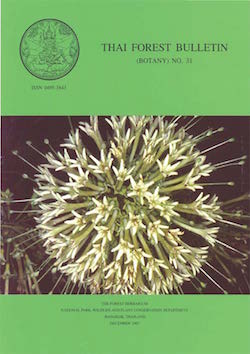Thai Rubiaceae with hooks and thorns
Keywords:
Rubiaceae, ThailandAbstract
Several woody Thai Rubiaceae (ca. 30 taxa) are distinguished by the presence of thorns or hooks (curved or recurved thorns). Most of these taxa belong to the tribe Gardenieae (Catunaregam, Ceriscoides, Dioecrecis, Fagerlindia, Oxyceros, Tamilnadia), two to the Vanguerieae (Canthium, Meyna), and one to the Coptosapelteae (Uncaria). The climbing hooks of Uncaria spp. morphologically represent modified inflorescence stalks, while thorns are vegetative lateral shoots with limited growth in all other taxa. In Ceriscoides, thorns are short lateral branches which, in turn, bear very abbreviated leafy and/or floweringshoots. In the monotypic Tamilnadia, short lateral branches terminally bear one or two pairs of short thorns. In the monotypic Dioecrescis, paired thorns are primarily on lateral shoots which occur in clusters in the lower part of the trunk. In the remaining taxa, thorns are short shoots produced in the leaf axils of long shoots, often together with leafy and/or flowering short shoots (accessory bud/shoot formation; thorns then always above the leafy and/or flowering brachyblasts; one or the other may not be developed). Thorns are either straight or curved (sometimes within a genus, e.g. Canthium spp.). The presence of curved thorns or hooks is associated with a climbing or straggling habit (Uncaria; Thai Oxyceros spp.; amongst the thorny Thai Canthium spp., only those with such a habit have curved thorns). Noteworthy is the presence of two different types of hooks (and shoot morphology) within Oxyceros. A key to the taxa is provided.
Downloads
Downloads
How to Cite
Puff, C., & Chamchumroon, V. (2014). Thai Rubiaceae with hooks and thorns. Thai Forest Bulletin (Botany), (31), 65–74. retrieved from https://li01.tci-thaijo.org/index.php/ThaiForestBulletin/article/view/24405
Issue
Section
Articles


